Light Amplification by the Stimulated Emission of Radiation
Table of Contents
- What is the difference between normal light and laser light?
- Key Concepts
- Resonator and Oscillator
- Pumping Schemes
- Laser Materials (advantages and disadvantages)
- Configurable Laser Characteristics
- Design Considerations
What is the difference between normal light and laser light?
- Monochromaticity (Spectral Purity) and Wavelength (Color)
- Intensity
- Divergence (Directionality) and Coherence
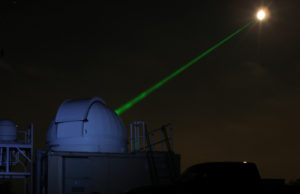
A remote sensing laser being utilized at a NASA observatory, lasers have a lot of research applications.
Monochromaticity and wavelength, or color, are related. The wavelength specifies the color at which the laser lases and the monochromaticity specifies the “purity” of that color. White light, like light from the sun or a light bulb, is composed of all colors; each color has its own associated wavelength. A laser emits in only a very small portion of the spectrum. We speak of red lasers or green lasers or blue lasers but not white light lasers.
The intensity, indicates how much light is present. Although the total amount of energy emitted by the sun is much greater than the energy emitted by a laser, in the narrow spectral region (color band) in which the laser lases, the laser’s output energy far exceeds that of the sun or any other known source.
Directionality and coherence. Normal light sources, like a flashlight, a light bulb, or the sun, emit energy in all directions. A laser, on the contrary, emits light only in a very well defined direction. Like a crowd of people entering a ball park, normal sources emit light with a random phase. In contrast, like soldiers marching in formation, lasers emit light at only one phase: a property called coherence.
Key Concepts
- Population Inversion
- Energy levels
- Fluorescence
- Lifetime
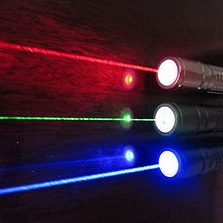
Lasers come in all sorts of configurations that can change color, wavelength, intensity, and other qualities.
Population inversion is at the very heart of a laser: without population inversion, you cannot have a laser. Just like water seeks its lowest energy level by flowing downhill, in a normal atom, the electrons orbit the nucleus in the lowest available energy level, called the ground state. Just as we can pump water uphill and fill a pond at the top of a hill, we can artificially populate the atom’s higher energy level by adding energy to the atom. This new state is known as the excited state or the upper laser level.
This process is familiar to most of you. Most of us have had “glow in the dark toys.” During the day, the toy absorbs sunlight and stores the energy as electrons in the exited state. Some time later, the electrons spontaneously fall back to the ground state. This process is called fluorescence and the length of time the electron remains in the excited state is called the lifetime.
Returning to a discussion of lasers, if a photon of the correct frequency passes near a atom in the excited state it stimulates the electron in the upper laser level to drop into the lower laser level and emit a photon. This process is where the “stimulated emission” comes from in Light Amplification of the Stimulated Emission of Radiation.
The device which creates the population inversion is called the (laser) pump and the process by which the population inversion is created is called pumping the laser.
Resonator and Oscillator
- Mirrors
- Laser Material
- Pump source
- Output coupler
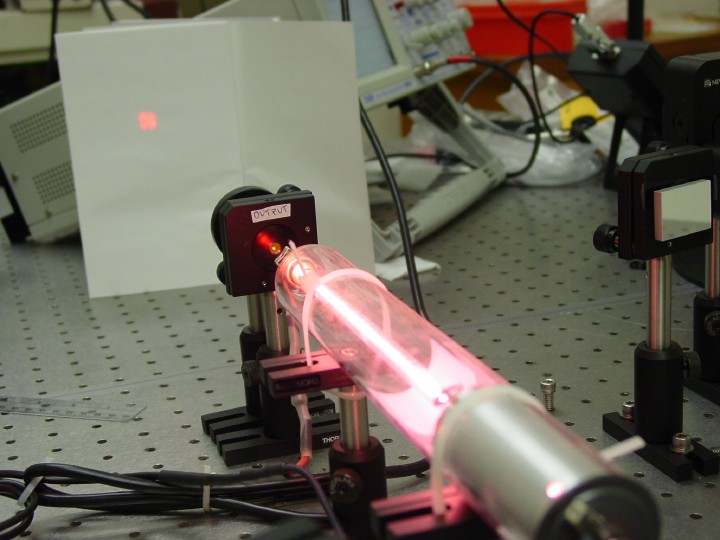
A laser at the Optical Physics Laboratory of UVA, mirrors on either side of the glowing plasma tube constitute the laser’s optical resonator.
A highly reflecting (HR) mirror redirects the photons back to the laser material. A partially reflecting mirror acts as the output coupler by allowing some energy to exit the
resonator. At the same time, some energy is reflected back to the laser rod providing feedback to keep the process going. The laser medium is a crystalline rod while a flashlamp pumps the laser.
Basically, this laser operates in the following manner.
The pump creates a population inversion. Some of the electrons spontaneously drop into the ground state emitting a photon in the process. These electrons are emitted in all directions. After a time, a photon will be reflected from the high reflectivity mirror back into the lasing material where it will stimulate other electrons to drop to the ground state.
Some of these photons will, in turn, be reflected from the partially reflecting mirror back into the lasing material where they will stimulate other electrons to drop into the ground level. This is called feedback and it will keep the lasing process going until the excited state is depopulated.
Some of the emitted photons will be transmitted through the mirror to become the output laser beam.
A resonator is an oscillator without a gain medium, or any material that it will lase. We talk about resonators because they are optically somewhat easier to analyze than oscillators. The gain medium does effect the optical properties of a laser.
Pumping Schemes
- 4 Level laser
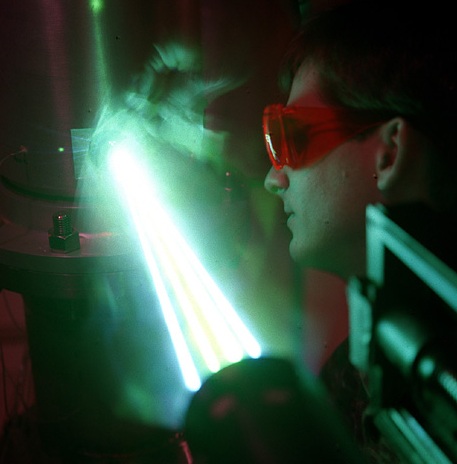
An engineer at the Marshall Space Flight Center (MSFC) Wind Tunnel Facility uses lasers to measure the velocity and gradient distortion across an eight inch curved pipe with joints and turning valves during a cold-flow propulsion research test; simulating the conditions found in the X-33’s hydrogen feedline. Lasers are used because they are non-intrusive and do not disturb the flow like a probe would. The feedline supplies propellants to the turbo pump. The purpose of this project was to design the feedline to provide uniform flow into the turbo pump.
- Using a flashlamp:
- neg:
- efficiency
- lifetime
- pos:
- price
- availability
- neg:
- Using a laser diode
- neg:
- wavelength restrictions
- price
- pos:
- efficiency
- power
- neg:
- Using another laser
- neg:
- wavelength restrictions
- efficiency
- cost
- complexity
- pos:
- wavelength
- power
- neg:
- Using a flashlamp:
- Quasi-4 level laser.
Most lasers are 4 level lasers. An electron is pumped from the ground state to the pump level. The electron relaxes to the upper laser level. Lasing takes place between the upper laser level and lower laser level. Finally, the electron in the lower laser level relaxes to the ground state.
There are several reasons why 4-level lasers are commonly used:
- First, many times the absorption to populate the upper laser level directly is inefficient while absorption to populate one or more higher energy levels is efficient.
- Second, many times several energy levels above the upper laser level are pumped and they all relax to the upper laser level. This increases the efficiency of the laser.
- Third, for lasing to take place, a population inversion is formed between the upper and lower laser levels. If the lower laser level is not normally occupied (i.e., is not the same as the ground state), then a population inversion takes place as soon as the first electron is pumped into the upper laser level. In contrast, if the lower laser level and the ground level are the same, then we have to pump more than half of the electrons to the upper laser level to create a population inversion. This translates into to a potentially large difference in output power for the same amount of pumping.
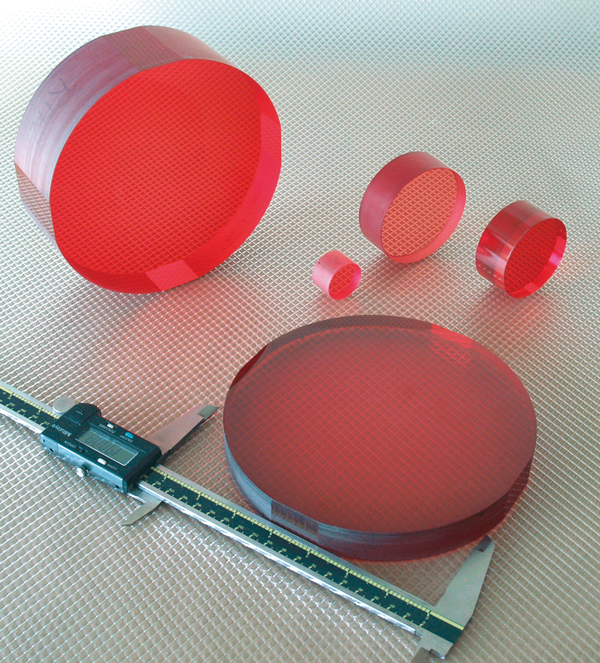
Ti:Sapphire – Sapphire crystals
Ti:Sapphire (titanium:sapphire) has a broad absorption band: it efficiently absorbs light throughout the visible spectrum. A flashlamp, a pump that flashes like a light bulb when pulsed with an electric current, emits a similarly broad spectrum of light. The greatest absorption efficiency occurs when the pump emits most of its light into the spectral bands where the laser material absorbs. An energy level diagram for this material would show a dense concentration of energy levels in the pump band.
Flashlamps are often used to pump lasers because of their ready availability and their price. Unfortunately, for many reasons they are not very efficient pump sources. Further, because they have a limited lifetime, they must be frequently replaced. When the flashlamp is replaced, the laser must be realigned and recalibrated, a time-consuming procedure.
Contrast Ti:Sapphire’s absorption spectra with the absorption spectra for Nd:YAG. The Nd absorbs in narrow bands scattered throughout the visible. A pump that emits into one of these absorption bands would be much more efficient than a pump with a broad spectral emission like a flashlamp. Two light sources have such a narrow light output: other lasers and laser diodes. Both kinds of light sources have been used as pumps.
Because Nd:YAG almost has an absorption peak at the peak laser diode emission spectra, the increase in pumping efficiency makes laser diodes the “pump of choice" in situations where input power is limited and a premium can be paid for laser efficiency. Unfortunately, laser diodes are still quite expensive. Because laser diodes are only available for a limited number of wavelengths, they are not as commonly used for pumping as flashlamps. An added advantage of laser diodes over flashlamps is that the pump energy which does not go into lasing is turned into heat energy. Because laser diodes are more efficient pumps, less wasted heat is produced. Because less wasted heat is produced, cooling systems for laser diode pumped lasers are simpler than cooling systems for flashlamp pumped systems.
Some laser materials contain 2 active materials Tm (thulium) and Ho (holmium). Absorption spectra for Tm:YAG and Ho:YAG look much like the absorption spectra for Nd:YAG: all 3 materials have narrow absorption bands scattered throughout the visible region of the electro-magnetic spectrum. Because Ho does not absorb energy well, Tm is added to absorb the pump energy. An atom such as Tm is called a sensitizer. The electron in the Tm pump level relaxes to the upper laser level of the Ho atom. Ho lases between its upper laser level and its lower laser level. Although the lower laser level is in the same manifold as the ground state, the lower laser (energy) level and the ground state are different.
Laser Materials (advantages and disadvantages)
- Gas: HeNe
- Advantages:

Gas laser diagram
- Price
- Availability
- Disadvantages:
- Gas tube can leak limiting lifetime
- Limited wavelengths
- Power limitations
- Advantages:
- Liquid: Dye laser

Solid state laser diagram
- Advantages:
- Tunability
- Disadvantages:
- Dyes have lifetime
- Dyes may be toxic
- Containment problem
- Advantages:
- Solid: Solid state lasers (mostly crystals), Nd:YAG
- Advantages:
- No containment problem
- Lifetime
- Disadvantages:
- not many hosts available
- Quality of materials
- Growth facilities
- Dissipating excess heat
- Advantages:
Solids, liquids, and gases have all been made to lase.
Many kinds of gas lasers exist, each lasing only at a few wavelengths. The gas is contained in a tube fitted with optical quality end-pieces which is placed between the laser resonator mirrors. One of the most common gas lasers is the bright red, low power, HeNe laser: cheap, easily available, and reliable. They are used as bright, collimated light sources in lab. HeNe lasers are continuous wave (CW) lasers, which means they constantly emit energy until they are turned off. They are not optically pumped; rather, they are pumped by radio frequency electrical discharges between the ends of the laser tube. Disadvantages of gas lasers include containment problems: many of the gases are corrosive and toxic. A failure mode is leakage of the gas tube. Further, gas lasers are available only in some special wavelength regions and their output power is limited. To their credit, the natural line width of gas lasers tends to be much smaller than the line width for solid or liquid lasers.
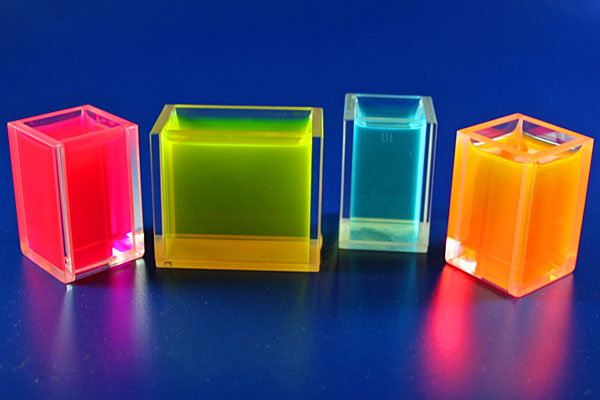
Laser dyes, available in many different configurations to cover a large range of wavelengths.
Dye lasers are lasers in which an organic molecule is suspended in a liquid or gel. Because dye lasers have broad emission spectra, they are tunable; i.e., the user has some control over the laser wavelength. Unfortunately dye lasers have some serious draw backs: they have very short lifetimes, the dyes are toxic, and the liquid/gel must be contained in an optical quality container.
For materials with a broad emission spectrum, the laser wavelength is determined by the spectral losses in the laser resonator. The laser will lase at the wavelength at which the upper laser level is most quickly depopulated. By suppressing (increasing the losses of) wavelengths we don’t want to lase, the laser will lase at the desired wavelength. Alternatively, we can select a laser wavelength by injecting a low power laser of the desired wavelength.
The laser beam slowly builds up power with each pass thorough the laser material. Often many wavelengths are competing to lase, to depopulate the upper energy levels. Eventually, one wavelength will be more efficient at stimulating electrons to drop from the excited state to the lower laser level and a laser pulse will form. If a low power laser beam is injected into the laser oscillator before any wavelength is allowed to become the dominant laser wavelength, the laser will lase at the wavelength of the injected beam. This is called injection seeding a laser.
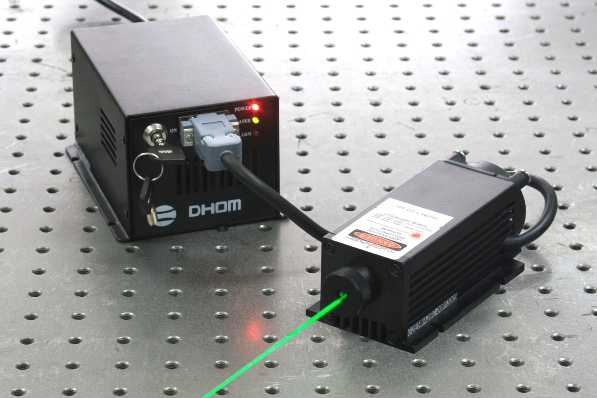
Pictured above, a standard solid state laser. Solid state lasers don’t require the gas containment resonator tube that gas lasers have, and they have no issue with containment.
Injection seeding is used to control the laser wavelength for materials with a broad emission spectrum. Because the process of selecting a laser wavelength entails large losses, the seed laser is much more inefficient than the slave laser. In situations where a specific wavelength, narrow spectral width, and high output power are required, building a seed/slave laser combination based on a tunable laser material is often the most efficient (and cost effective) alternative.
Solid state lasers don’t have the containment, toxicity, and lifetime problems associated with gas
and liquid/gel lasers. Some solid state laser materials can have broad absorption and/or emission features, some do not: it varies from active ion to active ion. Consequently, flash lamp pumping is efficient in some cases, but not always. Further, some solid state lasers are broadly tunable, some are not. Given good laboratory practices, solid state laser materials are long-lived.
Solid state lasers do, however, have two major problems:
- A small number of suitable hosts
- Heat dissipation
Most solid laser materials are large crystals with active ions added: it is the active ions that lase. A crystal has a repeating pattern of atoms. Crystals grow naturally: quartz, diamond, ruby, emerald, and sapphire are all naturally occurring crystals. Natural crystals do not make good laser crystals: they have too many imperfections which degrade the optical quality of the laser and limit the output power, often to a level below the laser threshold. However, laser quality crystals can be grown artificially in the laboratory where an ion which will lase, called a dopant, replaces one of the atoms in the crystalline array. Not all active ions can be doped into all crystals. The active ion is not the same size as the atom for which it is a substitute in the crystal lattice. Because of the size mismatch between the active ion and the atom it replaces, the lattice is deformed, placing stresses on the crystal. Often these stresses limit the amount of dopant which can be added to the laser crystal. For example, usually no more than 1 in 100 available sites are replaced by Nd ions, a relatively large ion, when it is a dopant.
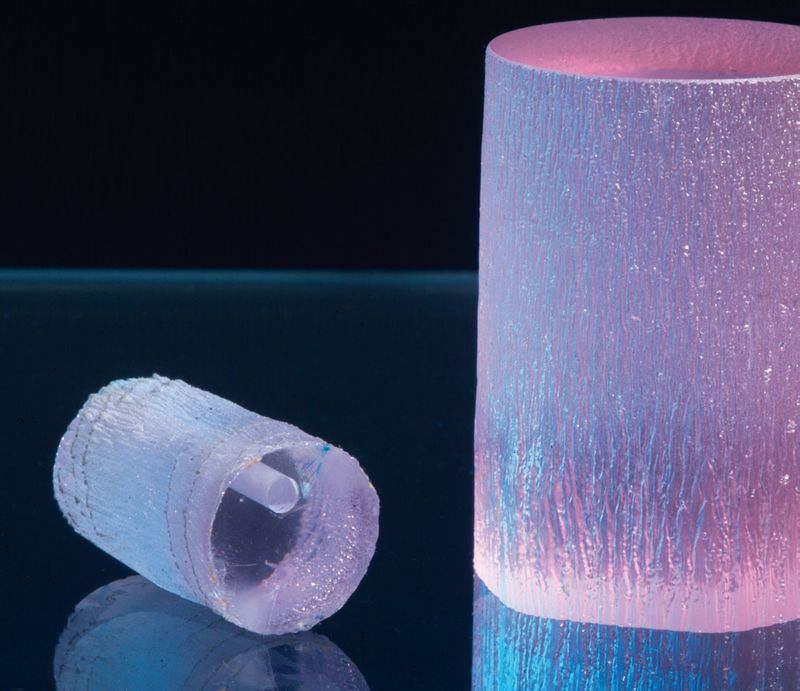
Nd:YGG crystal for direct generation of 935 nm pulses for water vapor measurement, from the Fraunhofer Institute of Technology.
Only a few solid state laser materials can be grown well: even many artificially grown crystals contain too many impurities and imperfections to make a laser or to make a very powerful laser. The quality of the optical elements in the laser oscillator, especially the gain medium, often limits the laser’s output power. Laser energy is absorbed by the imperfections and converted into heat, leading to strong temperature gradients in the element, be it a mirror, lens, or laser rod. Eventually, the stresses can become so strong that the element has a catastrophic breakdown; it shatters. Improving the quality of the laser crystal by developing new crystal growth techniques or by improving old ones often enables the laser engineer to build more powerful lasers. Further, new and/or improved crystal growth techniques are used to create new host materials. These new host materials (crystals without dopants) can increase the number of wavelengths at which lasers can be made to lase (by allowing compositional tuning), increase the efficiency for a given pump source, decrease thermal loading, and generally make the laser more efficient.
Finally, heat builds up in the laser crystal in two number of ways. Optical pumps emit light at wavelengths which are absorbed by the host, not by the active ion, which heats the crystal, not creates a population inversion. Alternatively, nicks, inclusions, and impurities absorb laser energy and convert it into heat energy. As alluded to earlier, temperature gradients in the laser rod can induce a sufficient amount of stress to shatter the laser rod, limiting laser output power to the designer’s ability to dissipate the waste heat.
Configurable Laser Characteristics
Laser characteristics over which a laser engineer has control can be divided into five broad categories:
- Spectral
- Wavelength (color)
- Spectral Line Width (spectral purity)
- Spatial
- Spatial distribution of energy (laser mode) and beam size (Gaussian beam)
- Divergence (directionality)
- Energy / Power
- Efficiency
- Output Power
- Temporal
- Temporal pulse width (normal mode vs. Q-switched)
- Repitition Rate
- Miscellaneous
- Reliability (simplicity)
- Lifetime
- Cost
We have already alluded to some of these parameters when we compared laser light and normal light. We touched on spectral properties when we discussed the laser’s color and spectral purity and we touched on spatial characteristics when we discussed the laser’s directionality. Let’s look at these and the other laser characteristics in more detail.
First we need to talk about the nature of light itself:
Light is an oscillating electric field which generates an oscillating magnetic field which in turn generates an oscillating electric field and so on as the light beam propagates through space. Hence we say that light is an electromagnetic wave.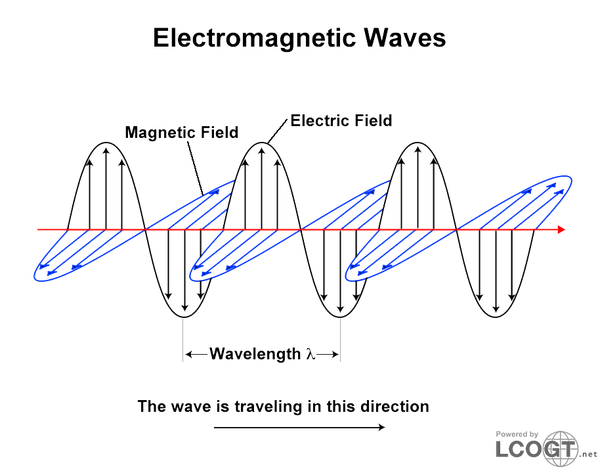
Armed with the knowledge that light rays are electromagnetic waves, we can discuss additional properties of a laser, beginning with its spatial properties. Although sound waves are changes in the density of air, sound waves and light waves have some properties in common. For example, if a guitar string is held down and plucked, the string will vibrate or resonate at only one wavelength or frequency. Similarly, each laser has fixed spatial modes in which it will resonate. Let us look at the laser beam by taking a cross-section of the beam perpendicular to its direction of propagation.
For a laser with circular cross-section mirrors, some of those modes are as follows:
The TEM00 mode, is represented by a solid circle: here all of the energy is contained within a central circular region.
Next, the TEM01 mode has two rings with a bright central region and a dimmer, thinner annulus surrounding it.
The TEM02 mode is like the TEM01 mode, except it has an additional, even thinner, dimmer ring surrounding the TEM01 mode. We could continue the TEM0n modes but I think you get the idea: each mode has an additional ring, the rings become dimmer, thinner, and closer together as we move to higher and higher modes. Energy moves out of the central circular region and into the surrounding annular regions. To capture a constant fraction of the total energy as we move to higher modes, we need to capture a larger area. Alternately, for a fixed sized detector, a smaller fraction of the total energy is captured as we move to higher modes. The TEM01* mode has a central dark spot surrounded by a ring of light. This ring is intermediate in size between the TEM00 mode and the TEM01 mode: it is larger than the TEM00 mode and smaller than the TEM01 mode. Similarity the TEM11* mode has a central dark spot surrounded by two rings of light. As before, the TEM11* mode is intermediate in size between the TEM01 mode and the TEM02 mode. Each mode diverges (increases in size as the distance from the beam waist increases) at a different rate with TEM00 mode growing the slowest.
Unless the laser engineer designs the laser to operate in the TEM00 mode, the laser will “mode hop”: the laser will try to lase in all the modes at once with each mode strengthening and weakening throughout the laser pulse. As the various modes become the dominant laser mode, the laser will appear to be lasing only in that one mode. “Hot spots” can form in the beam, leading to a catastrophic failure of an optical element, and severely limiting the output power of the laser. As we shall see, as the application changes, so do the properties of a laser which are of concern to the laser engineer. In some situations, the presence of hot spots can itself be a problem while in others “hot spots” are not a problem. For example, if the laser is being used for welding or cutting metal, hot spots are probably not a problem. However, where a repeatable, controlled amount and distribution of energy is needed, such as in laser eye surgery or the manufacture of printed circuit boards, the user probably wants the laser to operate in the TEM00 mode.
 Let’s take a closer look at the TEM00 mode, also called the fundamental or Gaussian mode. The energy density is not constant as we move outward from the center of the beam. Rather it smoothly decreases in the shape of a Gaussian curve. The beam radius is defined as the distance at which the intensity falls to 1/e2 (about 37 %) of it’s value at the peak. The intensity never drops to zero, although 99.9% of the energy is contained in a circle with twice the radius of the beam radius and only one one-millionth of the energy is outside of a ring with a radius three times the beam radius. Similarity the higher order modes have smoothly varying spatial energy distributions. Gaussian functions are relatively simple mathematical functions to manipulate, certainly easier than the mathematical functions that describe the higher order modes. In situations were a rigorous mathematical analysis is required, for simplicity, scientists prefer to use lasers operating in the TEM00 mode.
Let’s take a closer look at the TEM00 mode, also called the fundamental or Gaussian mode. The energy density is not constant as we move outward from the center of the beam. Rather it smoothly decreases in the shape of a Gaussian curve. The beam radius is defined as the distance at which the intensity falls to 1/e2 (about 37 %) of it’s value at the peak. The intensity never drops to zero, although 99.9% of the energy is contained in a circle with twice the radius of the beam radius and only one one-millionth of the energy is outside of a ring with a radius three times the beam radius. Similarity the higher order modes have smoothly varying spatial energy distributions. Gaussian functions are relatively simple mathematical functions to manipulate, certainly easier than the mathematical functions that describe the higher order modes. In situations were a rigorous mathematical analysis is required, for simplicity, scientists prefer to use lasers operating in the TEM00 mode.
There are advantages and disadvantages to operating a laser in the TEM00 mode. The advantages (which were discussed in the previous paragraphs) include: the smallest possible divergence, avoidance of “hot spots” in the output beam, shot-to-shot repeatability in output power, and simplicity of mathematical analysis of the beam’s interaction with the world. The biggest disadvantage is a loss in output power, which can be substantial (a factor of 5 or more).
| TEM00 Single bright circle TEM01* Single light circle with a dark area in the center (an annulus) TEM01 Solid circular center, encircled by a dark ring, which is in turn encircled by a thinner, less bright ring. TEM11* Same as TEM01 except the center circle has a dark spot in the middle TEM02 Same as TEM01 except an additional thinner, even less bright ring is present etc. |
||
| Intensity vs. Distance from the Beam Center: | ||
| Normalized Radial Distance | Normalized Intensity | Encircled Power |
| 0.83 | 0.60 | 0.76 |
| 1.0 | 0.37 | 0.86 |
| 1.5 | 0.10 | 0.97 |
| 2.0 | 0.02 | 0.99 |
Let’s turn our attention now to how the laser output changes as a function of time, the temporal properties of a laser. We will be talking about temporal modes of a laser. Please don’t confuse them with the spatial modes of a laser discussed earlier. The output power as a function of time for three kinds of lasers: a CW (continuous wave) laser, a pulsed laser running in the normal mode, and a Q-switched laser. CW lasers have a constant output from the time it is turned on until the time it is turned off.
The other two lasers are pulsed lasers: for them, the laser beam briefly cycles on and remains off for a longer period of time. The length of time the laser is lasing is called the pulse width and the number of pulses per second is called the repetition rate.
In a normal mode laser, a pulsed pump source, such as a flashlamp is used. The population inversion grows as the pump is turned on and ceases growing when the pump is turned off. As the population inversion grows, the minimum population in the upper laser level is established which is required for lasing to begin. As the pump output continues to increase, the laser output power also increases. When the pump is turned off, the laser continues to lase, but with decreasing energy until the population inversion falls below the threshold required for lasing to take place. The upper laser level will continue to become depopulated through spontaneous emission. The peak output power for normal mode, pulsed lasers is typically higher than the output power of a CW laser and the pulse width of a normal mode laser is broader than the pulse width for the Q-switched laser.
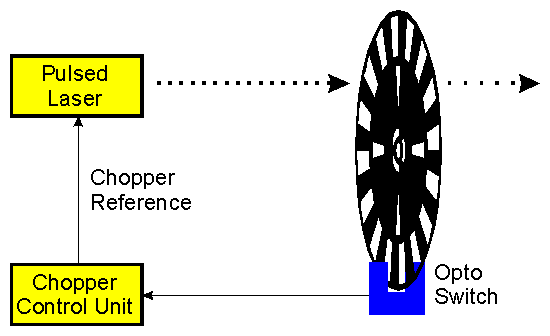 In the Q-switched laser, an optical element in the beam inhibits the laser action until it is removed or modified. Here, the pump source is allowed to complete its cycle and populate the upper laser level. Suddenly, the beam block is removed, the laser pulse grows rapidly, and a high power, narrow pulse width laser pulse is produced. A chopper, a wheel with regularly spaced holes placed on a spinning wheel, is an example of a simple Q-switch. The laser lases as long as the hole passes through the laser’s optical path. When the solid part of the blade is placed in the optical path, laser action is inhibited. Often, the chopper blade makes hundreds of revolutions per minute.
In the Q-switched laser, an optical element in the beam inhibits the laser action until it is removed or modified. Here, the pump source is allowed to complete its cycle and populate the upper laser level. Suddenly, the beam block is removed, the laser pulse grows rapidly, and a high power, narrow pulse width laser pulse is produced. A chopper, a wheel with regularly spaced holes placed on a spinning wheel, is an example of a simple Q-switch. The laser lases as long as the hole passes through the laser’s optical path. When the solid part of the blade is placed in the optical path, laser action is inhibited. Often, the chopper blade makes hundreds of revolutions per minute.
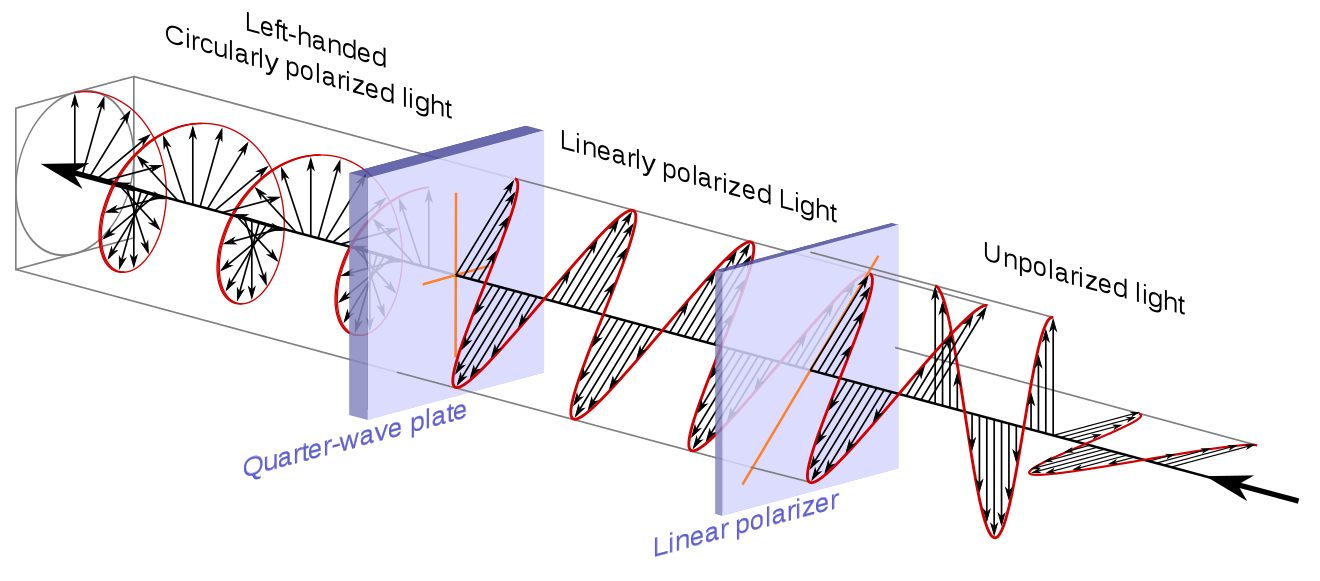
This diagram demonstrates how polarizing plates can be uses to manipulate the wavelengths of light that are being output by a laser.
A more sophisticated Q-switch exploits the properties of polarized light. Some materials transmit parallel polarized light while reflecting perpendicularly polarized light or visa versa. If an optical element composed of such a material, called a polarizer, is placed in the laser oscillator, the laser will lase with only one direction of polarization. Remarkably, a few materials change from transmitting to reflecting a particular
polarization depending on the surrounding electric field: such a material is called an electro-optical material. If we can restrict the laser to lasing in only one polarization and if we place an optical element made from an electro-optical material in the laser oscillator, we can turn the laser on and off by turning the electric field around the electro-optical material on and off. Our Q-switch then has 3 parts: a polarizer (which selects one plane of polarization), a Q-switch (an optical element made of an electro-optical material), and a Q-switch driver (the Q-switch’s power supply and associated electronics).
As we saw in an earlier example, each technique of implementing a concept has advantages and disadvantages. Mechanical and electro-optical Q-switches each have plusses and
minuses. The technique which is selected in any given case depends on the specific requirements of that laser.
As an aside, I would like to refresh your memory as to the difference between power and energy. Power refers to the output energy at any small instant in time: energy refers to the total amount of power emitted by the laser. Because the Q-switched laser pulse is high powered but is on only briefly it doesn’t necessarily emit a lot of energy. On the contrary, a CW laser can be a low power laser that emits a lot of energy. The difference between high power and high energy is the difference between a spark from a glowing fire landing on your foot and a warm heating pad residing comfortably on same-said foot on a cold winter afternoon. Some applications require high power lasers while others require high energy lasers.
The laser efficiency is defined as the ratio of the laser output power to the power put into all parts of the laser. Laser efficiencies are typically in the single digits and often smaller. Laser are a very inefficient way of creating light. But when the special properties of lasers are required to get the job done, then we have to use them anyway. For low power, low energy lasers, laser inefficiency is not a big concern. For some high power lasers used in some applications, increasing the efficiency by a factor of 2 is both highly desirable and a non-trivial problem.

This diagram shows how an amplifier can be used in conjunction with mirrors to increase output energy. In this diagram the mirrors let the laser pass through the amplifier multiple times, further increasing the laser amplification.
There are still two common techniques which we haven’t discussed that are used to increase laser output power. In the simpler technique, we add some gain material, pump it to create a population inversion, then inject a laser beam. The laser material will amplify the input laser signal, but it will not lase onits own. In some cases amplifiers are an attractive option. Normally a laser beam is a few millimeters in diameter. The gain medium is at least three times that in diameter, often more. And the beam retraces the same optical path each time it makes a trip through the resonator. The absorption is strongest at the edges of the rod. Hence much of the population inversion is wasted because the parts of the laser rod that contain much of the population inversion are never used and do not contribute to the laser output. On the other hand, with a judicious placement of mirrors, the laser beam can be made to pass through the amplifier several times, each time depopulating different regions of the gain medium. Hence adding an amplifier stage can be an efficient way of increasing the output power of a laser.
The other technique used to build high power lasers, which is unfortunately suitable only for high gain materials, is an unstable resonator. As mentioned in the previous paragraph, in stable resonators, the laser beam repeatedly traces the same path through the resonator. In unstable resonators, the laser beam traces out a slightly different path on each pass through the resonator, converting a larger fraction of the population inversion to laser light. Early unstable resonators used output couplers that had a smaller diameter than the laser beam diameter. Hence the output beam had a not very useful spatial energy profile: it looked like a donut with a dark spot in the middle. Newer unstable resonator output couplers, called Gradient Reflectivity Mirrors, have a reflectivity profile that varies smoothly from the center of the mirror to the edge and produce an output Gaussian beam. Because a typical reflectivity spot size is 1-2 mm and lasers require hard coatings, coating technology limited the availability of suitable mirrors. Unstable resonators were not seriously investigated until coating technology was sufficiently developed to produce Gradient Reflectivity Mirrors at a reasonable price. Today, unstable resonators are not common, but neither are they the exotic technology they once were.
Design Considerations
Finally, there are several design considerations that either do not fit into the previous categories or deserve to be amplified.
Lifetime: If an element in the laser has a short lifetime, it must be replaced often, requiring the laser to be realigned and recalibrated. Replacing a worn out element leads to downtime and the consequent maintenance costs. In some situations, even getting to the laser to take it to the laboratory for refurbishment can be a problem. For lasers that are to be flown on a satellite, replacing a worn out part is completely out of the question. Hence for space-related applications, all parts of the laser must be expected to last a long time. Some laser elements with relatively short lifetimes include: gas cells in gas lasers, dye cells in dye lasers, flashlamps, and some Q-switches.
Repeatability: For pulsed lasers, how much variation is there between the spatial and temporal characteristics of successive pulses? How much variation in these characteristics can the application withstand?
Coating Hardness: Optical coatings must be specially designed to withstand the high peak power of high power lasers. Otherwise, the coating is burned off of the element.
Cleanliness and Laser Quality Optical Materials: To create a high power laser, cleanliness is next to godliness. Smudges, dust particles, nicks, inclusions, and other defects in the material become locations for absorbing the laser energy, causing a local hot spot. The resulting temperature gradient is often enough to cause stress fractures (similar to the fractures in an ice cube that result from it being dropped into a glass of room temperature liquid.) These stress fractures become centers of absorption which cause more fractures and so on until the element shatters.
Laser Host Material Quality and Dissipating Waste Heat Laser crystals that are not grown well often absorb either pump energy or laser beam energy. This energy does not go into populating the upper laser level, rather it goes into heating the crystal. Indeed, for flashlamp pumped lasers, most of the energy emitted by the pump does not wind up pumping the laser, it winds up heating the crystal, causing large amounts of excess heat. This heat must be taken out of the rod or after a few minutes, heat stresses will cause it to shatter. Usually, a liquid coolant flows around the laser rod: the coolant flows through a chiller where it is cooled before being returned to the laser head. It is customary to avoid liquid coolant loops on spacecraft for reliability purposes.
Eye Safety and High Voltage Supply: High power lasers, even moderate power lasers in the visible part of the spectrum to which the eye is most sensitive, can easily destroy one’s eyesight. In contrast, some regions of the electro-magnetic spectrum are relatively eye safe. Every laser must be evaluated for its potential to cause eye damage. In many cases, special precautions must be taken to avoid eye damage.
Further, Q-switches and flashlamps usually require high voltage sources. Special attention must be paid to making those portions of the laser safe both for the user, the maintainer, and the casual visitor who may be unfamiliar with lasers. Also, these elements can limit the lifetime of the laser.
Miscellaneous Laser Design Considerations
Lifetime
Repeatability
Coating hardness
Cleanliness and available quality of optical materials
Laser host quality and dissipation of excess heat
Eye safety and high voltage requirements
Cost and ease of maintenance.
As a summary of this laser tutorial, I present a schematic of a laser that some one might wish to build. The laser has three parts: a seed laser, a slave laser, and a one-stage amplifier. The seed laser, a stable resonator, contains line narrowing elements (a 3-stack birefringent filter and an etalon) and a Q-switch (Q-switch, polarizer, and Q-switch drive electronics) for temporal line narrowing. An aperture is used to force the laser into the TEM00 mode. A pair of turn mirrors folds the beam back on itself to make the package more compact. The slave laser, an unstable resonator, contains a Q-switch in addition to the gain medium. Finally, the pulse feeds a single stage amplifier. When you add timing electronics, pump power electronics, and Q-switch electronics, not to mention the electronics necessary to drive the alignment, calibration, and measurement equipment, the system can become a bit complex. Auxiliary optical elements, often including a low power HeNe laser, are also needed for alignment, calibration, and test.